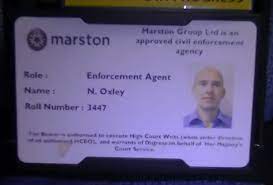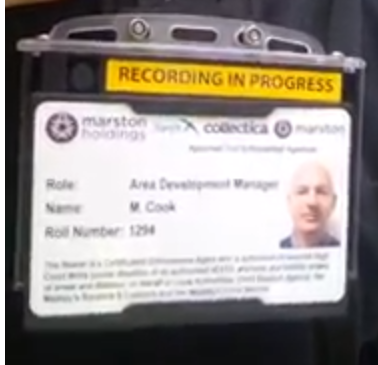Dealing with Bailiffs
Get Bailiff Bodycam Footage Legally Fast
Key Takeaways
- CPR 31.17 provides a court-supervised route to obtain body-worn camera footage from bailiff companies before formal proceedings begin.
- This method is superior to GDPR-based DSARs because it compels disclosure through enforceable court orders, not voluntary compliance.
- DSARs are limited to personal data and are often misinterpreted or obstructed by bailiff companies.
- Failure to comply with a CPR 31.17 order can result in sanctions, adverse inferences, or the striking out of a defence.
- Misuse or deletion of bodycam footage may lead to findings of contempt or procedural misconduct where litigation is contemplated.
- Bailiff excuses for non-disclosure are often legally baseless and may undermine their position before the court.
- CPR 31.17 enables early access to crucial evidence which can help resolve disputes or support claims for damages before costly litigation ensues.
Accessing Bailiff Body-Worn Camera Footage Using CPR 31.17
In disputes involving enforcement agents, particularly where unlawful conduct, damage to goods, or regulatory breaches are alleged, the availability of body-worn camera footage can prove decisive. While it is commonly believed that access to such footage must be pursued through a data subject access request under the General Data Protection Regulation (GDPR), there is a far more powerful and strategic procedural tool available to litigants: the pre-action disclosure mechanism under Civil Procedure Rule 31.17.
What CPR 31.17 allows
CPR 31.17 permits a person who is likely to be a party to subsequent proceedings to apply to the court for disclosure of documents from a person who is also likely to be a party to those proceedings. To succeed, the applicant must show that the documents sought are relevant to the dispute, that disclosure is desirable in order to dispose fairly of the anticipated proceedings, and that it will assist the resolution of the dispute or save costs. This approach is particularly appropriate where body-worn video footage from a bailiff may prove or disprove misconduct, a regulatory breach, or damage to goods or property.
Limitations of data subject access requests
The advantage of CPR 31.17 over a data subject access request under Article 15 of the GDPR is twofold. First, a DSAR is only effective in relation to personal data, which bailiff companies often narrowly interpret. If the applicant is not visible in the footage, or only partially shown, enforcement firms will often argue that the data is not personal within the meaning of Article 4(1) of the GDPR, and deny access on that basis. Second, the DSAR process lacks judicial teeth. There is no contempt jurisdiction for failure to comply within the one-month timeframe. The recourse lies only in making a complaint to the Information Commissioner’s Office under Article 77 of the Regulation or in bringing a claim for damages under Article 82 of the GDPR and section 168 of the Data Protection Act 2018. Both remedies are slow and uncertain.
The power of the court to compel disclosure
In contrast, CPR 31.17 empowers the court to compel production of specific documents, including audio-visual recordings, ahead of formal proceedings. The court may impose deadlines for compliance and grant costs orders against non-compliant parties. If the application is successful, the respondent is under a legal duty to provide the materials, and failure to do so could lead to sanctions, including adverse inferences or the striking out of any eventual defence under CPR 3.4(2)(c).
Why CPR 31.17 is preferable in urgent cases
This procedure is also preferable where there is urgency or a risk of evidence being deleted. A bailiff company that is served with a CPR 31.17 application becomes subject to court oversight, which offers far more robust protection than the vague compliance mechanisms of the data protection regime. In situations where a claimant needs to demonstrate that a vehicle was damaged during enforcement, or that a vulnerable person was mistreated, or that entry to premises was unlawful, the footage will almost always be the primary evidence. The production of such material can clarify facts before costs are incurred issuing proceedings and enable a more accurate valuation of the claim.
How companies may miscategorise your request
It is common for bailiff companies to miscategorise a request under CPR 31.17 as a data protection matter. This confusion can be strategically useful. Their written refusal or mistaken reliance on GDPR exemptions can be placed before the court as evidence that they have either misunderstood their obligations or are seeking to avoid disclosure. The court may treat such behaviour as obstructive, and it can influence the eventual award of costs or the credibility of the respondent's case.
When CPR 31.17 should be used
If enforcement is contemplated or has already taken place, and the presence or content of body-worn camera recordings is in dispute, then CPR 31.17 provides the most effective route to compel production of this evidence. It avoids the procedural ambiguity of data protection claims, operates within a judicial framework that can enforce compliance, and provides a credible route to ensuring that evidence is preserved and disclosed under supervision of the court.
Conclusion
In summary, while the GDPR creates a basic statutory right of access to one’s data, it is the machinery of CPR 31.17 that provides a precise, enforceable, and cost-effective means of obtaining the materials needed to bring a claim against bailiffs or their employing firms. For those who are serious about litigation or wish to resolve matters pre-action with full evidentiary knowledge, CPR 31.17 is the superior legal mechanism.


Remedies
- Apply to the court under CPR 31.17 to compel the bailiff company to disclose body-worn camera recordings before proceedings are issued.
- Use CPR 31.12 with an N244 application to obtain an unless order where disclosure has been refused or delayed.
- Seek a strike-out of the defendant’s case under CPR 3.4(2)(c) if they fail to comply with a court order to disclose the recordings.
- Submit a complaint to the Information Commissioner’s Office under Article 77 of the GDPR if the footage is not provided following a DSAR.
- Bring a claim for damages under Article 82 of the GDPR and section 168 of the Data Protection Act 2018 for material and non-material harm caused by unlawful denial or deletion of personal data.
- Present correspondence and refusal letters as evidence to support your case on disclosure, obstruction, or adverse inference.
CPR 31.17 offers a faster and more enforceable route than GDPR requests for obtaining bailiff bodycam footage. If you believe a bailiff has acted unlawfully or damaged your property, act quickly by sending a pre-action disclosure request and, if ignored, apply to court using Form N244. Preserve any correspondence and keep a timeline of events to support your case.
